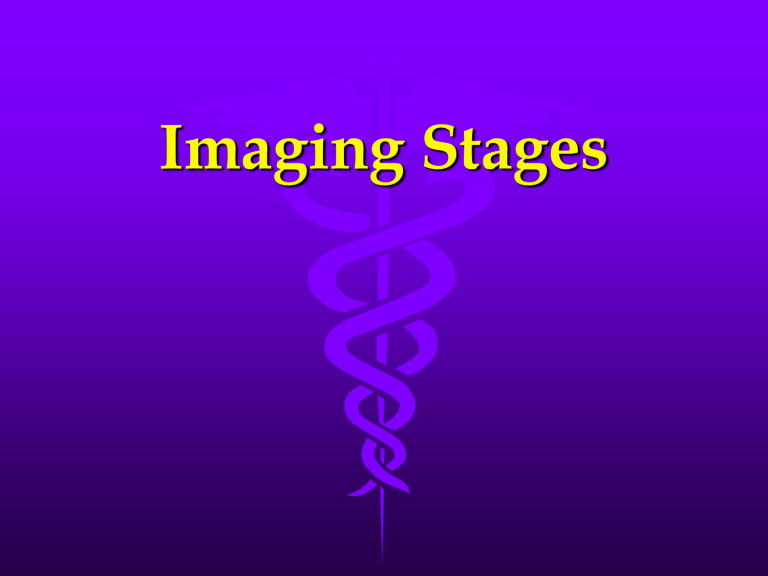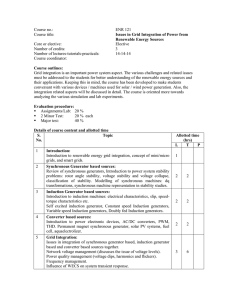
Imaging Stages
Learning Objectives
• Define the key terms used in digital
imaging
• List the equipment needed to perform
digital imaging
• Explain the computed radiography
(CR) digital system
• Explain the digital radiography (DR)
system
J.GENER R.R.T.,MA.Ed.
Learning Objectives
• Compare CR and DR digital systems
• Recognize the importance of using
exposure technique charts with digital
imaging
• Describe the processing and postprocessing of a digital image
• Explain what a picture archival and
communications system (PACS) is and
how it is used
J.GENER R.R.T.,MA.Ed.
Imaging Stages
1.
2.
3.
4.
Image Acquisition
Image Processing
Image Display
Image Storage
J.GENER R.R.T.,MA.Ed.
Analog
An analog system uses an intensifying screen to
create a latent image on x-ray film. The film is
then processed, creating a manifest image
that can be interpreted by a physician. It is
later stored in the file room.
J.GENER R.R.T.,MA.Ed.
Problems with Film:
• 10% of films are not available when we want them!
• 15% of films are “hard” to locate or find!
• Search for films will approach 20 to 90 minutes per
case
• 25% of films are “misplaced” or not retrievable
(misfiled).
• 10% of films are lost (referrals, residents, etc.)
• Recent study – physicians spend two weeks/year (100
hours/year) trying to locate or find the films they need.
• Cost in physician time is estimated from $60 to $80
per study.
J.GENER R.R.T.,MA.Ed.
Consider This About Typical Radiology
& Diagnostic Imaging Departments:
• 82% are profitable.
• 56% are the No. 1.
source of revenue.
• 44% are also measured
as #1 Cost Center.
• 69% could be more
profitable.
• 75% can increase
productivity/efficiency
• 68% now mandated to
reduce costs by more
Source: Radiology Management, Volume 23 No 1
than 12% within 15
J.GENER R.R.T.,MA.Ed.months.
Cost of Film Over 7 Years:
{$15.82 Per Film Per Exam Per Year}
100,000 exams/year @ $1,600,000
It Is Estimated That A Single Sheet Cost $50 Over Its Life
(Purchase, sort, utilization, storage, handling, staffing, disposing)
7
6
5
Film
Supplies
Staff
Overhead
4
3
2
Dollars
1
0
1997
1996
1995
Source: Mayo Clinic Film Expense Study, 1997
J.GENER R.R.T.,MA.Ed.
Digital Imaging
Digital Imaging is any modality
that creates an image that can
be viewed or stored on a
computer.
J.GENER R.R.T.,MA.Ed.
Digital Modalities
• CT (1970’s)
• Fluoroscopy
• MRI
• Nuclear Medicine
• Mammography
• Ultrasound
• X-Ray
J.GENER R.R.T.,MA.Ed.
DR / Direct Radiography
In a system of direct radiography, also called direct
capture radiography, the image receptor is
composed of an array of electronic sensors that
respond to the radiation exiting the patient. These
sensors send that information in digital format to a
computer.
J.GENER R.R.T.,MA.Ed.
Digital Radiography
• Referred to as “cassette-less” because the
detector is incorporated into the x-ray
table or upright wall unit
• Equipment may be indirect or direct
conversion
• Images are ready for viewing within seconds
J.GENER R.R.T.,MA.Ed.
DR / Charge Coupled Device
J.GENER R.R.T.,MA.Ed.
DR / Charge Coupled Device
High Radiation / High Noise Zone
X-ray tube
Low Radiation / Low Noise Zone
Scintillator
Lens
J.GENER R.R.T.,MA.Ed.
CCD
CR / Computed Radiography
J.GENER R.R.T.,MA.Ed.
Computed Radiography
• Image obtained
using cassettes
containing
photostimulable
phosphor plates
• CR systems
equipment
includes reader
for image
processing
J.GENER R.R.T.,MA.Ed.
CR / Computed Radiography
Note: The phosphor plates used in
computed radiography are not as
sensitive to light as x-ray, but are
extremely sensitive to scatter radiation.
J.GENER R.R.T.,MA.Ed.
Digital Imaging System
Technical Considerations
• Kilovoltage
• May be slightly higher than that used for
conventional radiography
• Centering
• Body part of interest must be placed in or near
the center of the detector
• Multiple exposures on one cassette
• Although not recommended, if IR is divided
for two separate exposures, the portion not
being exposed must be covered with a lead
J.GENER R.R.T.,MA.Ed.
shield
Digital Imaging System
Technical Considerations
• Over- and underexposure
• Degree of image density is not an accurate
indicator of over- or underexposure
• Density may be indicated by a unique
number that correlates to the amount of
exposure
• Collimation
• Limit the field of radiation to the anatomy
of interest
• Inadequate collimation can result in
inappropriateJ.GENER
contrast
R.R.T.,MA.Ed.
Digital Imaging System
Technical Considerations
• Open cassettes
• An exposed IR begins to lose the image
within 15 seconds of opening the IR
• Grids
• Digital systems are more sensitive to
scatter radiation
• Use grids as appropriate
J.GENER R.R.T.,MA.Ed.
Body Part Algorithms
J.GENER R.R.T.,MA.Ed.
Digitizing
X-Ray Digitizer – A scanner used to
convert existing analog images into a
DICOM format.
J.GENER R.R.T.,MA.Ed.
Image Matrix
J.GENER R.R.T.,MA.Ed.
Image Matrix
•Pixel
•Voxel
•Dynamic
Range
J.GENER R.R.T.,MA.Ed.
Histogram/Brightness Level
J.GENER R.R.T.,MA.Ed.
Soft Tissue
Lung
J.GENER R.R.T.,MA.Ed.
Window Level and Width
J.GENER R.R.T.,MA.Ed.
Window Level and Density
J.GENER R.R.T.,MA.Ed.
Window Width and Contrast
J.GENER R.R.T.,MA.Ed.
Window Width and Contrast
J.GENER R.R.T.,MA.Ed.
Exposure Technique Charts
• Ability to manipulate the computer
image contrast and density does not
eliminate the need for technique charts
• Use technique charts to select mA, kVp,
and time to avoid unnecessary patient
exposure
J.GENER R.R.T.,MA.Ed.
“Dose Creep”
J.GENER R.R.T.,MA.Ed.
Dose Response Curve
J.GENER R.R.T.,MA.Ed.
Noise
J.GENER R.R.T.,MA.Ed.
Viewing the Image
• The computer-processed
image can be viewed on a
computer monitor or
printed on film or paper.
• For an image on a screen
to have the quality
approaching that of a film
image, a special monitor
must be used with a
resolution of 1024 x 1024
pixels.
J.GENER R.R.T.,MA.Ed.
Image Processing and
Post-processing
• Both allow image manipulation of
• Density
• Structures demonstrated
• Subtraction permits viewing of bone only or
tissues only
• Contrast enhancement adjusts contrast from
very high to very low
J.GENER R.R.T.,MA.Ed.
Post Processing Techniques
•Subtraction
•Contrast Enhancement
•Edge Enhancement
•Black and White Reversal
J.GENER R.R.T.,MA.Ed.
Digital Subtraction
J.GENER R.R.T.,MA.Ed.
Edge Enhancement
J.GENER R.R.T.,MA.Ed.
Contrast Enhancement
J.GENER R.R.T.,MA.Ed.
Black and White Reversal
J.GENER R.R.T.,MA.Ed.
QA Software
• Repeat Analysis
• Dose Consistency Reporting
J.GENER R.R.T.,MA.Ed.
Advanced Annotations
•
•
•
•
•
•
•
Positioning Markers
Add predetermined text or free text
Zoom and roam image
Invert image
Apply shutters
Show/hide histogram
Advanced measurement options (Orthopedic
Application)
• Stitching for full leg/full spine
J.GENER R.R.T.,MA.Ed.
DICOM
Digital Imaging and Communications in
Medicine
DICOM is the format that nearly all
medical images are displayed in . It is
similar to JPEG or GIF formats for images
in computer languages.
J.GENER R.R.T.,MA.Ed.
PACS
Picture Archival and Communications
System
J.GENER R.R.T.,MA.Ed.
Picture Archival and
Communication Systems
(PACS)
• PACS used to manage images
• PACS network consists of
• Computers
• Servers
• Archives
J.GENER R.R.T.,MA.Ed.
J.GENER R.R.T.,MA.Ed.
What are the advantages of
PACS
• Faster delivery of medical images to the
clinicians that evaluate and report on them.
Resulting in faster availability of results.
• No lost or misplaced images, which means
fewer patients being postponed or cancelled
for consultations or surgery while waiting for
new images.
• Flexible viewing with the ability to
manipulate images on screen, which means
patients can be diagnosed more effectively.
J.GENER R.R.T.,MA.Ed.
What are the advantages of
PACS
• Instant access to previous images and
patient records.
• Better collaboration, as PACS can be
viewed from multiple terminals and
locations by a range of clinicians,
allowing discussion over diagnoses .
• Fewer unnecessary re-investigations,
which will in turn reduce the amount of
radiation to which patients are exposed.
• No space needed for film storage.
J.GENER R.R.T.,MA.Ed.
HIS/RIS
• HIS – Hospital Information System
• Patient demographic information entered
by the Facility at check in. (Electronic
Medical Record)
• RIS – Radiology Information System
• Study information entered by the
Radiology Department when the study is
ordered.
J.GENER R.R.T.,MA.Ed.
Fully Integrated System
With Agfa's IMPAX RIS solution you can
electronically manage your radiology
operations, end-to-end, from patient
registration through worklist
generation and medical reporting to
transcription and business intelligence.
Optional modules offer scheduling and
management reporting capabilities, to
provide a true end-to-end solution.
J.GENER R.R.T.,MA.Ed.
Summary
• With CR and DR the image is produced,
processed, viewed, and stored on a
computer
• CR uses an IR and requires a reader to
process the image
• DR is a cassette-less process that
produces an image within seconds
• Use technique charts to select exposure
factors
J.GENER R.R.T.,MA.Ed.
Summary
• The appearance of digital images can be
manipulated during and after processing
• PACS is a network used to manage the
images obtained through DR
• DR technical considerations include
kilovoltage, part centering, number of
exposures per IR, over- and
underexposure, cassette integrity, and
collimation
J.GENER R.R.T.,MA.Ed.
Clicker Question
Opening a cassette containing an
exposed imaging plate may result in:
a) an image with excessive density
b) an image with insufficient
density
c) erasure of the image
J.GENER R.R.T.,MA.Ed.
Clicker Question
Data acquisition in which x-ray energy
is converted to light and then to an
electric signal describes the DR process
of:
a) direct conversion
b) indirect conversion
J.GENER R.R.T.,MA.Ed.
Thank-You
J.GENER R.R.T.,MA.Ed.


